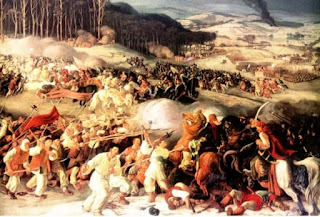The Battle of Stubica on February 9, 1573, the end of the great peasant revolt.
The Battle of Stubica on February 9, 1573, the end of the great peasant revolt.
Ottoman attacks from the end of the 15th century reduced the territory of Croatia to the "remains of the former glorious kingdom", and part of the Croatian territory was also occupied by the Venetians. The burden of wars, along with the nobility, fell mostly on ordinary peasants and serfs.
After complaining in vain to the emperor and the ban about the atrocities of the nobles, the peasants stopped paying unreasonable taxes in protest. Because of this resistance, the Croatian Parliament declared the peasants traitors to the homeland, to which they responded with a general uprising against the feudal lords.
On the night of January 27-28, 1573, the rebellion began with an attack on the Cesargrad fortress, and Ambroz Gubec (later named Matija, in memory of the "good king" Matija Corvinus) was chosen as the leader of the rebellion.
The insurgents did not limit themselves only to the overthrow of the unjust feudal order, but set up a program according to which they planned to abolish the power of the nobility, and to fight for the creation of an independent peasant state based in Zagreb, the establishment of a peasant government, which will take care of taxes and other payments for the defense of the homeland against the Turks.
The peasant movement spread rapidly, and the revolt affected 60 estates in the territory of Croatia and Carniola and Carinthia (today's Slovenia).
After initial successes, the feudal army soon suppressed the uprising. Already on February 5, 1573, near Krško serfs led by Nikola Kupinić were dispersed by Uskok captain Josip Thurn, and a day later the subban Gašpar Alapić defeated the serf army near Kerestinac.
On February 7, 1573, ban Drašković gathered an army in Zagreb to attack the insurgents in northwestern Croatia, where the majority of the insurgents under Gubec were operating (about 6,000), which, reinforced by the remnants of the broken detachments, grew to about 10,000 armed peasants.
The decisive battle took place on February 9, 1573, near the town of Stubica, where the peasant fortified camp was attacked by nobles (about 5-6,000 infantry and armored horsemen) under the leadership of subban Gašpar Alapić.
Although the peasants were poorly armed and almost without cavalry, in the decisive battle they put up such fierce resistance that the battle was uncertain until the help of 700 uskos arrived to the feudal army and after four hours of fighting, the rebels' battle array fell apart. About 5,000 peasants died (among them Ivan Mogaić, one of the leaders of the uprising), and a large number were captured.
After the battle of Stubica, reprisals were carried out against the peasants who were killed and maimed in the rebel settlements. After the battle, Matija Gubec was captured and taken to Zagreb, where he was executed on St. Mark's Square on February 15, 1573, in a very cruel manner. As the legend says, he had to wear a glowing crown on his head and after that he was dismembered.
The treatment of the nobility with the rebellious peasants after the suppression of the great peasant revolt in 1573 was described in the chronicle by Nikola Istvánffy:
"On all sides in the nearby trees and village houses they hung on cross-connected poles, so that everyone could see them, and on one very tall and branched wild pear tree, sixteen or more unfortunate peasants were hung from a rope and exposed to the winds and to the birds to peck at them. Some had their noses and ears cut off, so they were released mutilated so that they would forever bear the shameful memory of the rebellion and the impious raising of the sword against their masters. Gubec, the ominous leader of the criminal army and as they called him the king, was captured alive, which was especially dear to the nobility and its leaders, and brought to Zagreb. There Andrija Pasanec, his deputy in the army, was executed first. Then he was terribly mutilated with red-hot pincers, then crowned with an hot iron crown and finally dismembered like a bandit..."














Comments
Post a Comment